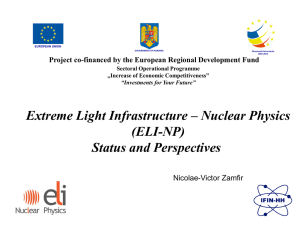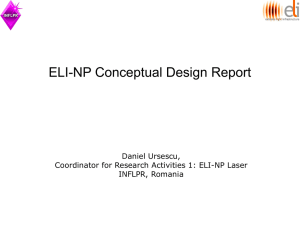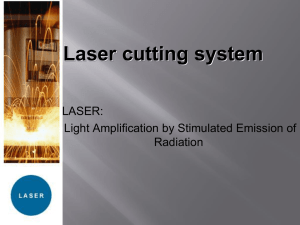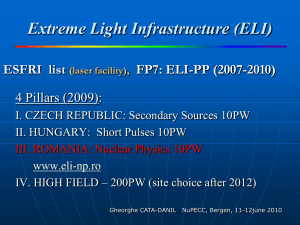ELI-NP_IonBeams_Paris2012_Tesileanu
advertisement
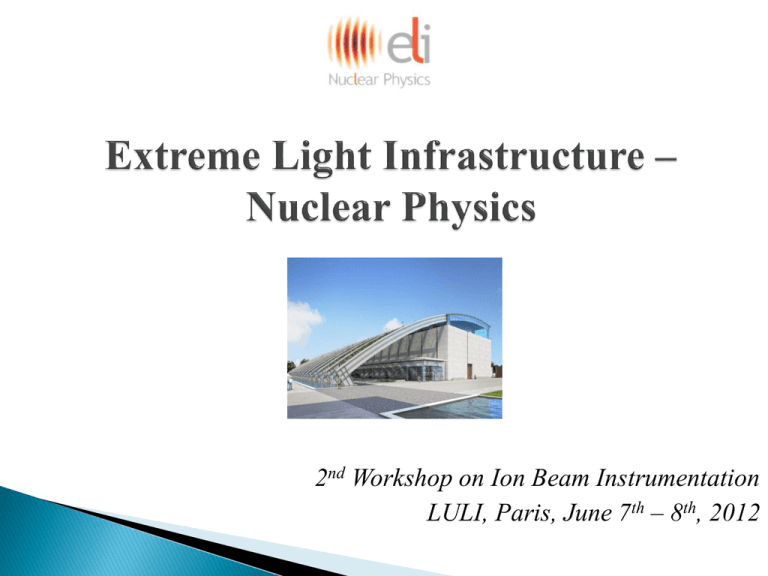
2nd Workshop on Ion Beam Instrumentation LULI, Paris, June 7th – 8th, 2012 Extreme Light Infrastructure (ELI) 2006 – ELI on ESFRI Roadmap ELI-PP 2007-2010 (FP7) ELI - Beamlines (Czech Republic) ELI - Attoseconds (Hungary) ELI - Nuclear Physics (Romania) Project Approved by the European Competitiveness Council (December 2009) ELI-DC (Delivery Consortium): April 2010 2 February-April 2010 Scientific case “White Book” (100 scientists, 30 institutions) (www.eli-np.ro) approved by ELI-NP International Scientific Advisory Board August 2010 Feasibility Study December 2010 – Romanian Government: ELI-NP priority project August 2011 – March 2012 Technical Design January 2012 Submission of the application for funding March 2012 Detailed technical design of the buildings. 3 Bucharest-Magurele Physics Campus National Physics Institutes BUCHAREST ring rail/road ELI-NP Lasers Plasma Optoelectronics Material Physics Theoretical Physics Particle Physics NUCLEAR Tandem acc. Cyclotron γ – Irradiator Adv. Detectors Life & Env. Radioisotopes Reactor (decomm.) Waste Proc. Large equipments: Ultra-short pulse high power laser system, 2 x 10PW maximum power, ultrashort pulses (300J, 30fs) Gamma radiation beam, high intensity and collimation, tunable energy up to 20MeV, bandwidth 10-3 Buildings – special requirements, 33000sqm total Experiments 8 experimental areas, for gamma, laser, and gamma+laser 5 ELI-NP Facility Concept High rep-rate laser experiments 0.1 – 1 PW Oscillators +OPCPA preamps 1PW block Apollon-type Ti:Sapph Flashlamp based multi-PW block Apollon-type Flashlamp based 400mJ/ 10Hz/ <20fs 30J/ 0.1Hz/ <30fs 300J/ 0.01Hz/ <30fs Oscillators + OPCPA preamps 1PW block Apollon-type Ti:Sapph Flashlamp based multi-PW block Apollon-type Flashlamp based Laser DPSSL 10J/>100Hz Gamma beam Compton based 0.1 – 20MeV e- accelerator Warm linac Multi-PW experiments Combined lasergamma experiments Gamma/eexperiments 6 ELI-NP Main buildings Lasers Gamma and experiments Laboratories Unique architecture Nuclear Physics experiments to characterize laser – target interaction Photonuclear reactions Exotic Nuclear Physics and astrophysics complementary to other NP large facilities (FAIR, SPIRAL2) Applications based on high intensity laser and very brilliant γ beams complementary to the other ELI pillars ELI-NP in Romania in ‘Nuclear Physics Long Range Plan in Europe’ as a major facility 8 Advances in lasers science Gerard Mourou, 1985: Chirped Pulse Amplification (CPA) 9 Particle acceleration by laser (Tajima, Dawson 1979) Target normal sheats acceleration (TNSA) Wake – field acceleration v FBz q B c E + s Secondary target - 1) v B pushes the electrons; 2) The charge separation generates an electrostatic longitudinal field: (Wake Fields or Snow Plough) cmo p 2 E s 4moc ne e 3) The electrostatic field: E s EL E~Ilaser1/2 -> secondary radiations Radiation pressure acceleration (RPA) E~ I laser Electrons and ions accelerated at solid state densities 1024 cm-3 10 Electrons Laser intensity ~ 1019 W/cm2 Collimated beams were obtained, even of the size of the incident laser beam The energies up to hundreds of MeV at high-power lasers (VULCAN, etc.) Intensities may go up to 1012 particles/laser pulse Esarey, Schroeder, and Leemans Rev. Mod. Phys., Vol. 81, No. 3, 2009 11 Protons, heavy ions Heavy ion beams at LULI (France) Laser pulses: 30 J, 300 fs, 1.05 μm => 5x1019 W/cm2. Target: 1 μm C on rear side of 50 μm W foils Detection: Thomson parabola spectrometers + CR-39 track detectors • Protons come from surface contamination • Heating the target the protons are removed and heavy ions are better accelerated 12 Proton acceleration • Maximum energy scales with laser beam intensity approximately as I0.5 • TNSA at work at intensities of 1019 – 1021 W/cm2 T. Lin et al., 2004, Univ. of Nebraska Digital Commons 13 Proton acceleration • Plateau of proton energy with increasing foil thickness • Graphs show results for multi-TW-class lasers LLNL 100fs, 1020W/cm2 (2001) T. Lin et al., 2004, Univ. of Nebraska Digital Commons Hercules laser, Michigan, 3x1020W/cm2, 30fs 14 Ion beam acceleration • Dependence of maximum energy function of the ion species • Graphs show results for multi-TW-class lasers Mylar target irradiated with a 1019W/cm2 laser pulse Vulcan 50TW, Appleton Lab, 2x1019W/cm2, thick lead target 15 E n 2 2 e 1 cos 1 e 2 4 E a02 e 2 0 mc e E0 4 e E0 n harmonic number ; recoil parameter; 2 mc eE a0 ; m0 E0 0 Compton backscattering is the most efficient « frequency amplifier » wdiff=4ge2wlaser Ee=300 MeV and optical laser <=> ge~ 600 => Eg > 3 MeV but very weak cross section: 6.6524 10-25 cm2 Therefore for a powerful γ beam, one needs: - high intensity electron beams - very brilliant optical photon beams - very small collision volume - very high repetition frequency 16 Absorption Separation threshold ´ gs AX ´ A´Y Nuclear Resonance Fluorescence (NRF) Photoactivation Photodisintegration (-activation) 17 Particle beams E1: laser-induced nuclear reactions – multi-PW laser experiments • protons E < 3GeV, I > 1011/pulse, div 40°, FWHM 300MeV • electrons up to 1.5GeV, I ~ 1011/pulse, div 40°, FWHM 150MeV E6: Intense electron and gamma beams induced by high power laser: • electrons E < 40GeV, I < 1011/pulse, div 1°, FWHM 1MeV E4/E5: Accelerated particle beams induced by high power laser beams (0,1/1 PW) at high repetition rates (10/1Hz): • • • Protons 100MeV, I ~ 1011 – 1013 / pulse, div 40°, FWHM 10MeV e- 50MeV-5GeV, I < 4*1010/pulse, div 1°-40° Thermal electrons, I ~ 107 E5 E6 E1 / pulse, div < 3° E8 E7 E3 E4 E2 Secondary particles Additionally, in E7 (Experiments with combined laser and gamma beams) and E8 (Nuclear reactions induced by high energy gamma beams), secondary particles will be created Low intensities Photodisintegration, photo-fission (E8) Laser focused in vacuum (E7) Laser-accelerated particles (E1, E6, E4, E5) Background may pose problems to particle detection E5 E6 E8 E1 E7 E3 E4 E2 Stand-alone High Power Laser Experiments Nuclear Techniques for Characterization of Laser-Induced Radiations Modelling of High-Intensity Laser Interaction with Matter Stopping Power of Charged Particles Bunches with Ultra-High Density Laser Acceleration of very dense Electrons, Protons and Heavy Ions Beams Laser-Accelerated Th Beam to produce Neutron-Rich Nuclei around the N = 126 Waiting Point of the r-Process via the Fission-Fusion Reaction A Relativistic Ultra-thin Electron Sheet used as a Relativistic Mirror for the Production of Brilliant, Intense Coherent γ-Rays Studies of enhanced decay of 26Al in hot plasma environments 20 Laser + γ /e− Beam Probing the Pair Creation from the Vacuum in the Focus of Strong Electrical Fields with a High Energy γ Beam The Real Part of the Index of Refraction of the Vacuum in High Fields: Vacuum Birefringence Cascades of e+e− Pairs and γ -Rays triggered by a Single Slow Electron in Strong Fields Compton Scattering and Radiation Reaction of a Single Electron at High Intensities Nuclear Lifetime Measurements by Streaking Conversion Electrons with a Laser Field. 21 Standalone γ /e experiments for nuclear spectroscopy and astrophysics Measuring Narrow Doorway States, embedded in Regions of High Level Density in the First Nuclear Minimum, which are identified by specific (γ, f), (γ, p), (γ, n) Reactions Study of pygmy and giant dipole resonances Gamma scattering on nuclei Fine-structure of Photo-response above the Particle Threshold: the (γ ,α), (γ,p) and (γ ,n) Nuclear Resonance Fluorescence on Rare Isotopes and Isomers Neutron Capture Cross Section of s-Process Branching Nuclei with Inverse Reactions Measurements of (γ, p) and (γ, α) Reaction Cross Sections for p-Process Nucleosynthesis 22 Applications Laser produced charged particle beams may become an attractive alternative for large scale conventional facilities Laser-driven betatron radiation - gamma beams High Resolution, high Intensity X-Ray Beam Intense Brilliant Positron-Source: 107e+/[s(mm mrad)2 0.1%BW] Radioscopy and Tomography Materials research in high intensity radiation fields Applications of Nuclear Resonance Fluorescence 23 Nuclear Resonance Fluorescence Applications • Management of Sensitive Nuclear Materials and Radioactive waste - isotope-specific identification 238U/235U , 239Pu, - scan containers for nuclear material and explosives • Burn-up of nuclear fuel rods - fuel elements are frequently changed in position to obtain a homogeneous burn-up - measuring the final 235U, 238U content may allow to use fuel elements 20% longer - more nuclear energy without additional radioactive waste 24 Radioisotopes for medical use • Ageing nuclear reactors that currently produce medical radioisotopes, growing demand – shortages very likely in the future • New approaches and methods for producing radioisotopes urgently needed • Feasibility of producing a viable and reliable source of photo fission / photo nuclearinduced Mo-99 and other medical isotopes used globally for diagnostic medical imaging and radiotherapy is sought • Producing of medical radioisotopes via the (γ, n) reactions e.g. 100Mo(γ, n) 99Mo • 195mPt: In chemotherapy of tumors it can be used to label platinum cytotoxic compounds for pharmacokinetic studies in order to exclude ”nonresponding” patients from unnecessary chemotherapy and optimizing the dose of all chemotherapy 25 Materials Science and Engineering • Due to the extreme fields intensity provided by the combination of laser and gamma-ray beams, novel experimental studies of material behavior can be devised • to understand, at the atomic scale, the behavior of materials subject to extreme radiation doses and mechanical stress in order to synthesize new materials that can tolerate such conditions • Extremely BRIlliant Neutron-Source produced via the (γ ,n) Reaction without Moderation • The structure and sometimes dynamics investigations by thermal neutrons scattering are among the obligatory requirements in production of the new materials • An Intense BRIlliant Positron-Source produced via the (γ, e+e−) Reaction (BRIP) – polarized positron beam – microscopy 26 Astrophysics – related studies • Production of heavy elements in the Universe – a central question for Astrophysics • Neutron Capture Cross Section of s-Process Branching Nuclei with Inverse Reactions • the single studies on long-lived branching points (e.g. 147Pm, 151Sm, 155Eu) showed that the recommended values of neutron capture cross sections in the models differ by up to 50% from the experimentally determined values • the inverse (γ,n) reaction could be used to decide for the most suitable parameter set and to predict a more reliable neutron capture cross section using these input values • Measurements of (γ, p) and (γ, α) Reaction Cross Sections for p-Process Nucleosynthesis • determination of the reaction rates by an absolute cross section measurement is possible using monoenergetic photon beams produced at ELI-NP • tremendous advance to measure these rates directly • broad database of reactions – high intense γ beam needed 27 ELI-NP Timeline • June 2012: Launch of large tender procedures • September 2012 – September 2014: Construction of buildings • 2014: TDRs for experiments ready • July 2015: Lasers and Gamma Beam – end of Phase 1 • December 2016 : Lasers and Gamma beam Phase 2 • January 2017: Beginning of operation 28 www.eli-np.ro Thank you! RPA in DLC foils Experiment Theory 2D PIC simulations 33 aim: determination of transition strengths: need absolute values for ground state transition width NRF-experiments give product with branching ratio: assumption: no transition in low-lying states observed but: many small branchings in other states? self-absorption: measurement of absolute ground state transition widths 34 Norbert Pietralla, TU Darmstadt ELI Workshop


